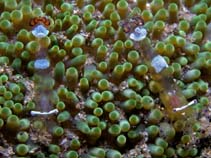Periclimenes brevicarpalis (Schenkel, 1902)
Glass anemone shrimpWarning: DOMDocument::load(): SSL operation failed with code 1. OpenSSL Error messages: error:140770FC:SSL routines:SSL23_GET_SERVER_HELLO:unknown protocol in C:\Apache24\htdocs\includes\SpeciesSummary.lib.php on line 1236
Warning: DOMDocument::load(): Failed to enable crypto in C:\Apache24\htdocs\includes\SpeciesSummary.lib.php on line 1236
Warning: DOMDocument::load(https://sealifebase.nrm.se/webservice/AquaMaps/getAMap.php?genus=Periclimenes&species=brevicarpalis): failed to open stream: operation failed in C:\Apache24\htdocs\includes\SpeciesSummary.lib.php on line 1236
Warning: DOMDocument::load(): I/O warning : failed to load external entity "https://sealifebase.nrm.se/webservice/AquaMaps/getAMap.php?genus=Periclimenes&species=brevicarpalis" in C:\Apache24\htdocs\includes\SpeciesSummary.lib.php on line 1236
Mandar um arquivo com seu (sua) Fotos
| Todas as fotos | Imagem do Google | Periclimenes brevicarpalis
| Todas as fotos | Imagem do Google | Periclimenes brevicarpalis
Classification / Names Common names | Synonyms | CoL | ITIS | WoRMS
| Decapoda | Palaemonidae
Environment: milieu / climate zone / depth range / distribution range Ecologia
Associadas(os) a recifes; intervalo de profundidade 1 - 15 m (Ref. 113378). Tropical
Distribuição Países | Áreas FAO | Ecossistemas | Ocorrências | Introduções
Indo-Pacific: Mozambique to Japan, Australia and Papua New Guinea.
Length at first maturity / Tamanho / Peso / Idade
Maturity: Lm ? range ? - ? cm
Descrição suscinta Morfologia
Body is transparent with large white spots. Four to five orange spots with a black ring are present on the tail fan. Purplish-blue rings are present near the joints and tips of pereiopods. Rostrum well-developed, with five to six dorsal, and two ventral teeth. Females are generally larger.
Minimum depth from Ref. 83472. Epizoic, Intertidal to subtidal (Ref. 106854). Associated with giant anemones (Ref. 113378). Usually found in pairs. Occasionally found on hard corals (Ref. 125532).
Life cycle and mating behavior Maturidade | Reprodução | Desova | Ovos | Fecundidade | Larvas
Members of the order Decapoda are mostly gonochoric. Mating behavior: Precopulatory courtship ritual is common (through olfactory and tactile cues); usually indirect sperm transfer.
Referência principal
Referências | Coordenador | Colaboradores
Bruce, A.J. 2005. (Ref. 83471)
Status na Lista Vermelha da IUCN (Ref. 130435)
Status no CITES (Ref. 108899)
Not Evaluated
CMS (Ref. 116361)
Not Evaluated
Perigo para os humanos
Uso pelos humanos
| FishSource |
Ferramentas
Mais informação
Fontes da internet
BHL | BOLD Systems | CISTI | DiscoverLife | FAO(Publication : search) | Fishipedia | GenBank (genoma, nucleotídeo) | GloBI | Gomexsi | Google Books | Google Scholar | Google | PubMed | Árvore da vida | Wikipedia (Ir para, procura) | Registro zoológico
Estimates based on models
Preferred temperature
(Ref. 115969): 22.9 - 29.3, mean 28.3 (based on 3320 cells).



